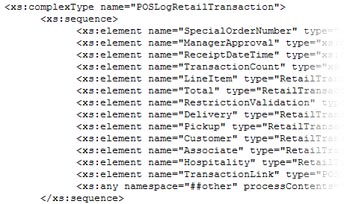Article
Making sense of software data standards
The Association for Retail Technology Standards recently upgraded three of its XML schemes to final standards. But factors like competition, legacy systems and a bewildering array of peripherals and drivers make standardization for self-service devices a tough nut to crack.
January 3, 2006 by James Bickers — Editor, Networld Alliance
On Dec. 15, the Association for Retail Technology Standards (ARTS) of the National Retail Federation placed the "final" tag on three of its public domain XML schemes. POSlog v2.1 details data captured at the point of sale, Price v2.0 defines data fields for pricing systems, and Customer v2.0 handles customer data for CRM and loyalty programs.
Those three standards are part of ARTS's IXRetail initiative, which aims to allow all retail devices to talk to one another - and, more importantly, makes sense of the data shared. IXRetail is a joint effort; the board of directors of the program includes companies and organizations such as IBM, Microsoft, NACS and Target.
But standardization has a tough road ahead, particularly in a fragmented industry like self-service, which includes many companies offering different solutions.
"The kiosk industry is working behind confined doors," said Naumann Ahmed, senior systems engineer for Infonox. "Every vendor has its own method of solving a problem. A more open approach is needed that exposes the transactions in XML fashion, so that it eventually is embraced by many and turned into a standard."
Back to basics
XML is short for extensible markup language, a tool for describing the various parts of a document or other piece of data. With XML, authors can create custom tags to define fields within the data - fields like name, address, product descriptions and so on. The number of potential tags for even a simple business transaction is enormous - the ARTS standard defines more than 4,000 different data elements.
 |
A sample of code found in ARTS's POSlog specification, which details how the data in a retail transaction is stored. |
And so it becomes increasingly desirable that certain fields always be formatted a certain way -hence the value of Price v2.0, for instance, which explicitly details how pricing data should be stored.
Sylvia Berens, president of Apunix Computer Systems, said the kiosk industry would do well to follow the lead of the petroleum industry, which has largely adopted XML standards, "and become involved in facilitating other verticals to follow the same direction."
Paying attention to the vertical you're working in is the first step. For retail, ARTS has several well-entrenched specifications in place, in addition to the three newly enshrined ones. UnifiedPOS, for instance, spells out the workings of POS devices, enabling them to work with one another regardless of operating system.
-- Sylvia Berens, Apunix Computer Systems |
"While there might be some special needs for kiosks, industry-wide standards like ARTS should be the first adopted," said Richard Mader, executive director of ARTS.
Of course, there is great potential profit in making all of this as easy as opening a box and installing a software package, and that's where Microsoft comes in. The company has been working hard to make retailers aware of Windows Embedded for Point of Service, a subset of Windows XP Professional that is specifically optimized for retail and hospitality kiosks. Among its attractive features, WEPOS makes plug-and-play functionality possible for retail peripherals.
Expert advice
So with all these choices, what's a retailer to do?
Berens said it is essential to choose systems that support open architecture, "regardless of which self-service vendor you choose to work with." She warns against choosing a proprietary system.
"Windows is not the answer for many appliance-like devices such as routers, digital video recorders, etc.," she said. "A self-service device is much more like one of those devices than it is a PC on someone's desktop. Windows is a closed, proprietary architecture. There are many ways a self-service device can be implemented - this industry should not be dictating the OS or method of implementation."
Jane Gilson, director of the Mobile and Embedded Devices division at Microsoft, said that whatever choices retailers make, deployers are wise to examine the infrastructures already in place within their businesses rather than reinventing the wheel.
"Do everything you can to limit complexity," she said. "Before buying new technologies, retailers should first leverage technologies that they already have within stores - specifically, they should try to use the same technology platform for their kiosks that they're already using for internal PC networks, POS systems and other devices. Also, they should strive to deploy technologies that are already familiar to their IT staff."





